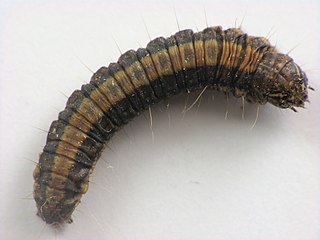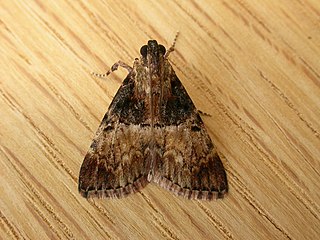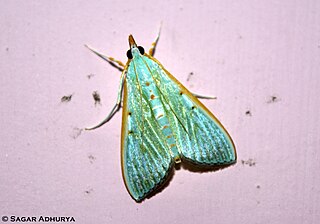
Spilomelinae is a very species-rich subfamily of the lepidopteran family Crambidae, the crambid snout moths. With 4,135 described species in 344 genera worldwide, it is the most speciose group among pyraloids.

Omiodes is a moth genus in the family Crambidae. Several species are endemic to Hawaii.

Bradina is a genus of moths of the family Crambidae.

Dichocrocis is a genus of moths of the family Crambidae. The genus was described by Julius Lederer in 1863.

Glyphodes is a genus of moths of the family Crambidae described by Achille Guenée in 1854.

Herpetogramma is a genus of moths of the family Crambidae described by Julius Lederer in 1863. It currently comprises 106 species and is found in North America, Eurasia, Australia, New Zealand, Central and South America. Of the few species where host plants are known, the larvae mostly feed on grasses.

Lamprosema is a genus of moths of the family Crambidae described by Jacob Hübner in 1823.
Orphnophanes is a genus of moths of the family Crambidae described by Julius Lederer in 1863.

Parapoynx is a genus of moths of the family Crambidae described by Jacob Hübner in 1825.

Phostria is a genus of moths of the family Crambidae.

Syllepte is a genus of moths of the family Crambidae.

The Epipaschiinae are a subfamily of snout moths. More than 720 species are known today, which are found mainly in the tropics and subtropics. Some occur in temperate regions, but the subfamily is apparently completely absent from Europe, at least as native species. A few Epipaschiinae are crop pests that may occasionally become economically significant.

The South Carolina School for the Deaf and the Blind is a school in unincorporated Spartanburg County, South Carolina, United States, near Spartanburg and with a Spartanburg postal address. It was founded in 1849 by the Reverend Newton Pinckney Walker as a private school for students who were deaf. The School for the Blind was established in 1855, and the school became state funded in 1856.

Orthaga is a genus of snout moths. It was described by Francis Walker in 1859.

Arthroschista hilaralis, also known as the kadam defoliator, is a moth in the family Crambidae. It was described by Francis Walker in 1859. It is found in India, Sri Lanka, Burma, Cambodia, Sumatra, Borneo and in Australia, where it has been recorded from Queensland.

Glyphodes pyloalis, the lesser mulberry snout moth, lesser mulberry pyralid or beautiful glyphodes moth, is a moth in the family Crambidae. It was described by Francis Walker in 1859. It is found in Iran, China, Japan, India, Indonesia (Sumatra), Sri Lanka, Taiwan, the Democratic Republic of the Congo, Equatorial Guinea, Mozambique and North America, where it has been recorded from Florida, Maryland, North Carolina, South Carolina and Virginia.

Nacoleia charesalis is a moth in the family Crambidae. It was described by Francis Walker in 1859. It is found in Australia, India, Sri Lanka, Borneo, Sumbawa, the Philippines, Singapore, Thailand, Japan, Taiwan and on the Seychelles.
Orphnophanes ankarampotsyalis is a moth in the family Crambidae. It was described by Hubert Marion and Pierre Viette in 1956. It is found on Madagascar.
Orphnophanes thoasalis is a moth in the family Crambidae. It was described by Francis Walker in 1859. It is found on Borneo.
Orphnophanes turbatalis is a moth in the family Crambidae. It was described by Hugo Theodor Christoph in 1881. It is found in the Russian Far East (Amur).














